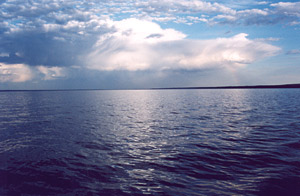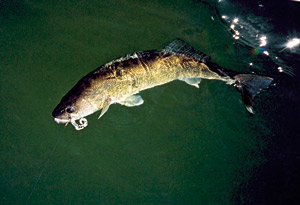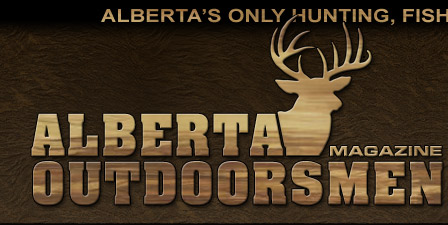|
 |
 |
A couple of years ago I wrote a column in this space called “The Pigeon Lake Dilemma.” That column focused on what was a very difficult, if not different type of problem that most lakes in Alberta would love to have—too many walleye. In fact, Pigeon Lake’s walleye population was, and still is, so big that it has impacted other species of fish that dwell within the same waters, namely perch and whitefish.
In that previous column I had talked to Ray Courschene of the Millet Fish and Game Association. Ray is the eyes and ears of Pigeon Lake and has spent several years studying the recruitment of walleye fry in Tide Creek. In that previous column Ray stressed that something had to be done with the walleye in the lake, there was just too many. While his studies of Tide Creek had shown that some walleye recruitment was taking place, it was still too low to allow a general harvest. His wish at the time was for the lake to become a put-and-take fishery with its own walleye hatchery, allowing for some form of harvest while getting control of an ever-growing walleye population that had tipped the predator-prey balance, slowly decimating the perch and whitefish populations in the lake.
 |
| The huge body of water known as Pigeon Lake will see a walleye harvest in 2006. |
To date, that hatchery is still only a dream and according to Courschene, it is likely to remain that way. “I still believe that’s the way to go. But Fish and Wildlife don’t want anything to do with it. I don’t know if it’s money or what, but the lake should be a put and take fishery,” said Courschene.
And as far as the recruitment goes, nothing has changed. “The creek is just too low,” said Courschene. “There is some spawning taking place but very little.”
But others have also been watching Pigeon Lake and they, namely our fish and wildlife division, also knew that something had to be done with this burgeoning population of walleye. With as many as 1500 cottagers situated around the lake and the sudden appearance of Métis nets, opening up a general season was definitely out of the question. Creating a put-and-take fishery with its own hatchery as Ray Courschene would like to see, would certainly not see the daylight in a fisheries budget. So, what to do?
For years Alberta’s hunters have lived under a system that allows for the taking of game while maintaining that game’s integrity. If the demand for a type of hunt is high, or a type of species needs to be managed for a specific purpose, then a system is put in place to achieve the desired results. That system is a “draw system” that has proven to be a very successful management tool. It is also very popular within the hunting community and is arguably the best system in place in Canada where fish and wildlife departments are concerned.
 |
| Alberta’s favourite eating game fish. |
For several years now, people like Ray Courschene and others have been calling for some form of harvest on Pigeon Lake and more than once the draw system has been brought up in conversation. It just made sense. A controlled harvest of walleye from a lake that basically needs thinning before irreparable damage is done to other species couldn’t make more sense.
And it now looks as though they may get their wish.
Slated for 2006 is the implementation of a draw system for walleye on four Alberta water bodies—Pigeon Lake, Wolf Lake, Lac St. Anne and Lake Newell will all have a limited harvest of walleye in 2006. This harvest will be given to lucky draw applicants and will allow the angler to keep one walleye from the water body they are drawn at. Details on how the draw system will be implemented have yet to be released but it is expected they will be announced in the 2006 Alberta Guide to Sportfishing Regulations slated to hit the shelves some time in mid-March.
This is good news for many Alberta anglers, but is it good for the fisheries long term? Using Pigeon Lake as an example, if it doesn’t have the ability to become self-sustaining as Ray Courschene believes, this limited harvest will have to be watched closely. If not, this prize fishery will regress back to its pre-stocking days.
“We’ve still got to stock it,” says Courschene emphatically. “There isn’t enough of a spawn taking place.”
But not a single walleye was stocked in Alberta in 2005, in any lake. In fact, the last walleye stocking that took place in Alberta was in 2003 when 1,980,000 walleye were stocked in Pine Coulee Reservoir. And considering Fish and Wildlife states quite clearly on its Fishing in Alberta website, “The primary intent of walleye stocking is to achieve self-sustaining populations, rather than maintenance of populations through continuous stocking” it is doubtful that a change can be expected any time soon.
So the question is how long will these four lakes handle a limited harvest of walleye before needing help once again through stocking?
One can only assume due diligence has taken place before any plans for a draw system were considered, and let’s face it, those running our Fish and Wildlife department seldom take unnecessary risks; the rebuttal to error is often just too long and too loud. Take Calling Lake as an example.
But what about the many anglers who wish these lakes remain closed to walleye fishing to retain their trophy qualities, and their ability to give up plenty of fish to the catch-and-release angler? Should things change and the fishing take a step backward, you can bet these same anglers will be making a lot of noise to our Fish and Wildlife department.
But for now this can only be viewed as a positive and a huge success story, further proof that walleye stocking can lead to improved opportunities for Alberta anglers.
Now, let’s get those draws in. ■
For previous Outdoor Pursuits click here.
|
|
|
|


